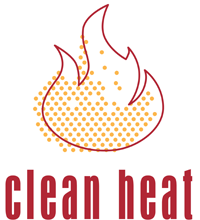Policy
Clean up the air! The European Union has already established a number of standards and regulations, which directly or indirectly influence wood burning.
An overview:
- Limits and efficiency specifications for stoves and boilers
- Air quality (immissions)
- National ceilings for air pollutants (emissions)

Limits and efficiency specifications
The European legislation on Ecodesign and energy labelling aims at removing the least efficient products from the market in order to contribute to the EU’s energy efficiency objectives. The eco-design requirements for solid fuel boilers (2015/1189/EU) and local space heaters (2015/1185/EU) will come into force in 2020 and 2022 and will include emission limits due to the health effects of biomass combustion. For stoves, these are at a similar level to the current regulations in Germany; for boilers, however, the requirements are weaker.
Current limits in Germany
In a European comparison, the Ordinance on Small and Medium-sized Firing Plants (1. BImSchV) is comparatively demanding. It contains specific requirements for permitted fuels and requirements for the maximum moisture content of wood. In addition, emission limit values for particulate matter and various other pollutants are specified. Since January 2015, new wood stoves and boilers must comply with stricter particulate matter limit values ranging from 20 mg/m3 to 40 mg/m3, depending on the type of plant and fuel used. By comparison, gas fired boilers emit significantly less than 1 mg/m3.
Old stoves that went into operation before the introduction of the regulation (2010) have less stringent limits. In addition, these do not have to be fulfilled immediately, but are staggered according to the year of approval of the systems (see table). If it can not be proven by manufacturer certification or by subsequent measurement that the stove complies with the limit values, the plant must be shut down or retrofitted with a particle separator.

Air quality (immissions)
The Ambient Air Quality Directive (2008/50/EC) sets air quality standards and limit value for a number of air pollutants. With regard to PM10, the limit value of 50 µg/m³ must not be exceeded for more than 35 days per year. The limit value for PM2.5 has entered into force in 2015 and aims at a maximum concentration of 25 µg/m3 (yearly average). The limits are much higher than the WHO recommendations. Nevertheless, many cities in the Member States have problems to meet these requirements. Therefore, the Commission already has started infringement procedures against many member states in order to enforce the air quality standards.
National ceilings for air pollutants (emissions)
Since 31 December 2016, the revised Directive on the Reduction of National Emissions of Certain Air Pollutants (2016/2284, NEC Directive for short) is in force and regulates emissions of harmful air pollutants such as sulfur dioxide, nitrogen oxides, ammonia, volatile organic compounds other than methane and particulate matter (PM2.5). By 2030, PM2.5 emissions across Europe will have to be reduced by 49% (compared to 2005). The policy measures adopted so far are not sufficient for this. Under national air pollution control programs, Member States must now decide what other means can be used to achieve this.


